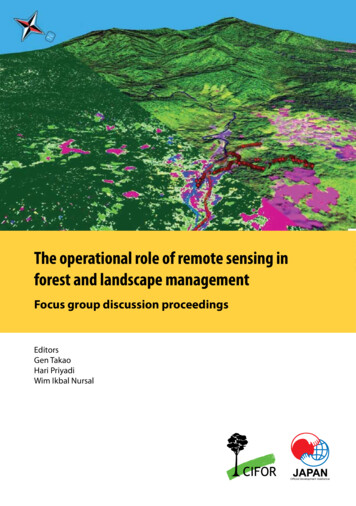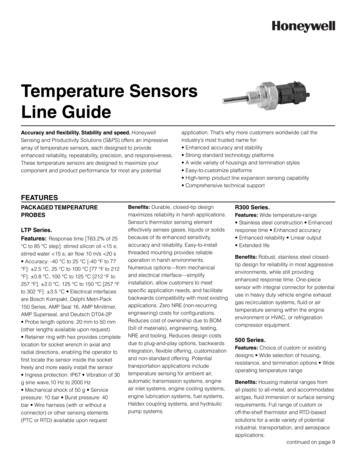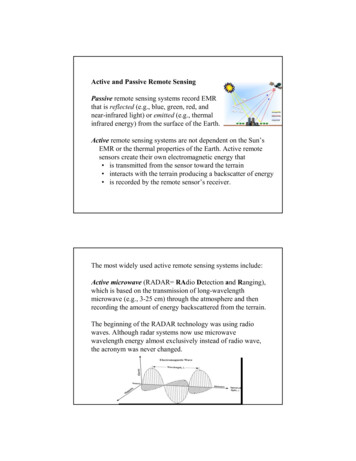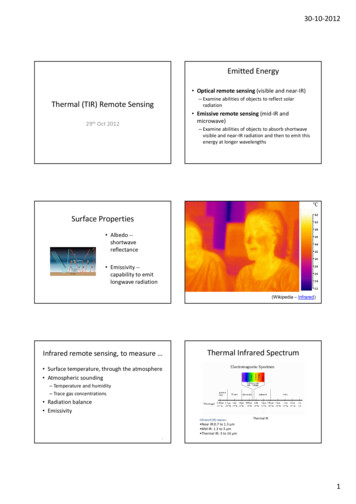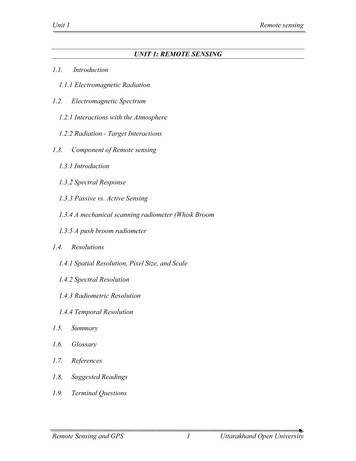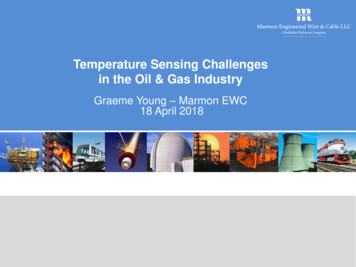
Transcription
Temperature Sensing Challengesin the Oil & Gas IndustryGraeme Young – Marmon EWC18 April 2018
Agenda Marmon Group and Global Markets Oil & Gas Market SegmentsUpstream ApplicationsMidstream ApplicationsDownstream Applications Distributed Fiber Optic Sensing - GlobalInstallations (source: FOSA) Temperature Sensor – Market Size Summary
The Marmon Group at a Glance Marmon Holdings, Inc., part of Berkshire Hathaway, Inc., isa global, diversified industrial organization employing20,000 people worldwide Marmon comprises four autonomous companies consistingof 16 diverse, stand-alone business sectors and 185independent manufacturing and service businesses.Marmon Engineered Components Company Engineered Wire & Cable (EWC)Distribution ServicesTubing, Fittings & Wire ProductsIndustrial ProductsEngineered Products & ServicesMarmon Food, Beverage & Water Tech. Company Food Service Technologies Beverage Technologies Water TechnologiesMarmon Retail & Highway Tech. CompanyMarmon Energy Services Company Rail Products & Services Intermodal Containers Crane Services Retail ScienceRetail Store EquipmentRetail ProductsHighway ComponentsTrailer & Truck Products and Services
Marmon Engineered Wire & Cable - Member Companies Marmon (EWC) is a unique group of 15 major cable and sensingCompanies; design and manufacture of cables and sensors for harshenvironments North America, UK (CCPI Europe) and India (Radiant-RSCC Joint Venture)Marmon EWC : 1600 employeesPower/UtilityApplied Supply/Support
Marmon Group – Global MarketsSource: MarmonHoldings Brochure2016
Oil and Gas Industry - Market SegmentsUpstream GeologicalSurveys Exploration &Production(E&P) “Wellbore”MidstreamDownstream Transportation:e.g. Pipeline,rail, tanker, truck LNG Terminals Storage Refining Petrochemical Marketing andDistribution
Upstream Application – In-Well Temperature MonitoringSAGD WellsApplication OutlineSteam Assisted Gravity DrainageBitumen / Heavy CrudeThermal Enhanced Oil recovery methodDownhole temperatures 235 – 3500CReduce viscosity of Bitumen, pump to surfaceContinuously monitor thermal profile of bothInjection & Production wellKey measurable SOR (steam-oil ratio) SOR typically 2.5 2.5 bbls steam to produce 1 bbl oilChallengesPermanently installed, long duration (years) Non-retrievable, no access to replacetemperature sensorHydrocarbon / Pressure environment; pressurebarriers, temperature cycling
Upstream Application - In-Well Temperature MonitoringSAGD WellsCurrent Temperature measurement methodsThermocouples (Bundles) – best long term durabilityDistributed Fiber Optic Sensing (DTS) At limit of Operating Temperatures (3000C) Limited life span, hydrogen darkeningEnhanced / New Temperature measurement methods – EMPRESS Projects Low Drift, Dual Wall Thermocouples – improved performance for long term installation Slimline integrated, self-validating thermocouples, potential development at 300 – 6000Crange (EMPRESS 1) Improved temperature measurement over long durations (years)Traceable Fiber Optic thermometry (ITS-90) Standardised calibration techniques for existing and new fiber optic sensors Traceable temperature measurements up to 6600C (improved coatings for FO) Phosphors, Bragg Gratings & Distributed Temperature Sensing(Note : IEC 61757-2-2 Ed. 1.en:2016. “defines detailed specifications for distributedtemperature measurement by a fiber optic sensor”)
Energy related In-Well Temperature Monitoring - GeothermalWells (Boreholes)Application Outline Renewable – Geothermal Electricity Generation California, Philippines, Indonesia, Iceland (tectonicplate boundaries); 20 Countries About 2800 wells, concentrated into ‘fields’ Current Technique used to monitor downholetemperature;- Thermocouples (downhole temperaturestypically above fiber optic capability)ChallengesPermanently installed, long duration (many years) Non-retrievable, no access to replacetemperature sensor, up to 3 miles deepTemperature range 3000C up to 6000C; vibrationNew / Enhanced Temperature Measurement techniques Low drift / slim-line self-validating thermocouples Traceable Fiber Optic Thermometry (ITS-90), highertemperature up to 6600C
Midstream Application – Pipeline Temperature MonitoringApplication Outline (Leak detection; temperature) Very efficient transport mode for hydrocarbons Leaks can be caused by ground movement, corrosion,material failure, 3rd Party intervention and alsoimproper operating procedures Continuous monitoring required for pipeline integrity Many different monitoring technologies;corrosion, pressure wave analysis etc andtemperature measurement along pipelineChallenges Permanently installed, long distance Retrofit monitoring difficult and expensive Underground and over ground pipelines Expansion, contraction, vibration during operation Ground movement over time Rapid indication of leak (small temperature change) Pipeline Leak Detection legislation API RP 1175
Midstream Application – Pipeline Temperature MonitoringCurrent Temperature Measurement Methods DTS – Distributed Temperature Sensing inconjunction with DAS (acoustic) and DSS (strain) In excess of 200 pipelines monitored using DTS Leaks –catastrophic to environment andreputations (HSE and shutdown costs)- Linear Asset Monitoring- Gas pipeline leak; Joule-Thomson effect- Oil pipeline leak; temperature changes (afew 0C for oil) external to the pipeEnhanced / New Temperature Measurement MethodsTraceable Fiber Optic Thermometry (distributedTemperature sensing) ITS-90Gas Pipeline monitoring (J-T effect)Temperature measurement is at the core of pipelinemonitoring however additional techniques are required forOil Pipelines – Entire Surface monitoring, Electromagnetic /Wave propagation etc for Pipeline leak detection
Midstream Application – LNG Pipeline and LNG PlantTemperature MonitoringApplication OutlineTransporting and storing liquefied natural gas (LNG)as a liquid (-1620C) 111 kelvin Temperature monitoring of LNG Plant, LNGPipelines, LNG Storage tanks Distributed Fiber Optic Temperature Sensing forLNG Pipeline monitoring ; LNG Tank monitoringhelically wrapped around inner tank (annulus) Fiber acts as a passive sensor; no electronics orpower; sensing immune to EMIChallenges Primary threat to safe LNG operation is tank /pipeline leakage Continuous real-time monitoring of entire LNGsurface area (tanks / pipelines) Rapid indication of small temperature changerequired
Midstream Application – LNG Pipeline and LNG PlantTemperature MonitoringCurrent temperature measurement methods Distributed Temperature Sensing (DTS) widely usedin LNG Plants at cryogenic conditions (-1620C) Fiber Optic sensing safe operation in explosiveenvironments Leaks catastrophic - people, environment andreputations Single point temperature measurements also usedin LNG PlantsEnhanced / new temperature measurement methods DTS temperature measurement, (Raman, Rayleighand Brillouin scattering); temperature becomesnon-linear at low temperatures (little data on this) Traceable (ITS-90) fiber optic thermometry at verylow temperatures (cryogenic); standardisedcalibration techniques Phosphor based temperature sensors for 2D Surfacemeasurement of LNG tanks / pipelines (as opposedto current linear DTS measurement)
Downstream Applications – Refinery / Petrochem GasifierSkin Temperature Monitoring (Reactor Vessels)Application Outline Refinery / Petrochem vessels where hightemperature processes require a refractory lining Gasifier - gasification of petroleum coke, bitumenand other heavy residues If the refractory lining fails, hot spots occur on theouter surface, which could result in catastrophicfailure Fiber acts as a passive sensor; no power; attachedexternally, sensing immune to EMI, vessel skintemperature measurement (fiber limit 3000C )Challenges Cost effective and complete coverage of the asset,within the limits of the fiber optic sensing cable(bend radius, time to install, longevity, spatialresolution) Refinery / Petrochem Gasifier skin temperaturesup to 3000C
Downstream Applications – Refinery / Petrochem GasifierSkin Temperature Monitoring (Reactor Vessels)Current temperature measurement methods Thermocouples (internal temp. measurement) Thermal imaging cameras, fixed and survey In low cost applications heat sensitive paint Distributed Fiber Optic Temperature Sensing (DTS)helically wrapped around the reactor vesselEnhanced / new temperature measurement methods Low drift Thermocouples Traceable (ITS-90) Fiber-based thermometry, single point and distributed up to 6600C- Higher temperature Fiber Optic Sensing Cable required 3000C to 6600C range Surface Temperature Monitoring (100% reactor vessel surface coverage)Other Refinery Applications (refractory lined reactors); Hydrotreaters / Hydrocrackers (4000C skin temperature)Fluid Catalytic Cracking Units (3000C skin temperature)Delayed Cokers (5300C skin temperature)Sulphur extraction Plants (1500C skin temperature)
Downstream Application – RefineryElectrical Distribution Equipment - Temperature MonitoringApplicationLarge refineries have 100’s of PDC’s (Power Distribution Centers) and MCC’s (MotorControl Centers)3,000 Refinery / Petrochemical plants worldwideCondition Monitoring (temperature measurement); Fire Detection ApplicationRecent IncidentPump malfunction caused electrical breaker issue that initiated fire in PDC area Safety, Environmental and Plant ShutdownCustomer RequestAbility to continuously monitor temperature ofPDC / MCC equipment real-time with historicalthermal data (hotspots) comparison over time; Improve Safety and Operational Uptime Improves predictive maintenance Drives preventative maintenance schedules
Downstream Application – RefineryElectrical Distribution Equipment - Temperature MonitoringCurrent temperature measurement methods Periodic (weekly) inspection of PDC’s with handheldInfrared Cameras No real-time continuous temperature monitoring Inconsistent surface location for inspection, Operatordependent No historical comparison of Thermal data for earlyindication of hotspotsPotential Solution Surface temperature measurement / QuantitativeThermal Imaging (identification of hotspots) Thermal Fingerprinting Continuous real-time Surface thermal monitoring Comparison of Thermal data over time, CM andFire Detection“Protection of both People and the Asset”
Distributed Fiber Optic Sensing Installations (Source : FOSA)
Distributed Fiber Optic Sensing Installations (Source : FOSA) FOSA : Fiber Optic Sensing Association (non-profit, founded 2017)1300 distributed fiber optic sensing installations worldwide (member companies)75 Countries / 20,000 miles of Fiber Optic sensing cablePredominantly Distributed Temperature Sensing (DTS); also includes DSS(distributed strain) and DVS / DAS (distributed vibration / distributed acoustic)Primary Applications– Power Cable Monitoring (22%)– Tunnel Monitoring (Fire Detection) (20%)– Pipeline Monitoring (13%) Accelerated Market Growth through traceability to ITS-90 for fiber optic sensors /measurement and development of standardised calibration techniques Distributed Fiber Optic Sensing – Market Size– 2016, 600M Sales– 2025, 2B forecast Sales(Note : IEC 61757-2-2 defines specifications for distributed temperature measurementby a fiber optic sensor)
Global Temperature Sensor Market“The temperature sensors market was valued at USD 4.99 Billion in2016 and is expected to reach USD 6.86 Billion by 2023, at a CAGR of4.5% between 2017 and 2023.The chemicals and petrochemicals industries are likely to hold majorshares of the temperature sensor market for process .by 2023”Source : Markets and Markets, July 2017 Customer needs in the Oil and Gas Industry are driving bothenhanced and new temperature measurement technologies Oil & Gas Industry drivers are Safety and Environmental together withimproved process control Oil & Gas Operators (IOGP) support and drive International Standards(IEC, ISO, API)
Summary (Applications / Temperature Measurement)Upstream (SAGD, Geothermal)Low drift thermocouples (dual-wall)Slim-line integrated, self-validating thermocouplesTraceable (ITS-90) Fiber-based thermometry up to 6600C (single point anddistributed)Midstream (Pipelines, LNG)Traceable (ITS-90) Fiber-based thermometry, distributed down to -1620CSurface Temperature monitoring (phosphor-based)Downstream - Refinery (gasifiers, reactor vessels) and PDC (Electrical distribution)Low drift thermocouples (dual-wall)Traceable (ITS-90) Fiber-based thermometry up to 6600C (single point anddistributed)Surface Temperature monitoring (phosphor-based)Oil & Gas Temperature Applications ranging from -1620C to 6600C
Questions
Traceable Fiber Optic Thermometry (distributed Temperature sensing) ITS-90 Gas Pipeline monitoring (J-T effect) Temperature measurement is at the core of pipeline monitoring however additional techniques are required for Oil Pipelines -Entire Surface monitoring, Electromagnetic / Wave propagation etc for Pipeline leak detection




